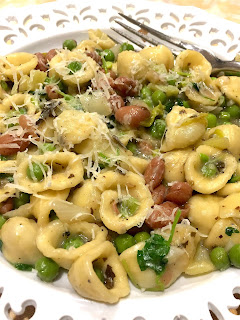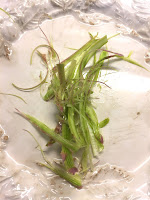Then I read with disbelief that the Pugliese do this in one pot to embue the pasta with broccoli flavor. So I figured I'd try it. And it works! It works so well, last night I tried it with fresh shelled peas and a few leftover canned borlotti beans. What a yummy virtuous dinner that made.
So if you'd like to try something different, here's what you need to know:
1. You need small pasta like the traditional orecchiette. Don't use fusilli or rotini or other pastas with lots of edges made to catch sauce. There's no real sauce here, so you're wasting their power. In lieu of traditional Pugliese orecchiette, you can use cencioni, farfalle, cavatappi, conchiglie (shells), cavatelli or just good ole macaroni. These are all small smooth pastas.
2. For the vegetable, broccoli rabe or baby broccoli aka mini broccoli or in a pinch the standard American large broccoli. You can also use fresh peas. I found a bit of celery and onion enhanced the pea version's final flavor. These two vegetables, broccoli and peas, work because they have strong, distinct flavor all by themselves, plus vivid color.
3. Top quality very fruity olive oil definitely adds to the final sparkle.
4. With broccoli, I add a few pine nuts for the crunch and protein. With the peas, I threw in some leftover light brown borlotti (Italian) beans for the protein push. Another name for canned borlotti beans is Roman beans and also cranberry beans. I also tossed in some pea shoots left in the fridge.In other words the recipe is not carved in stone. You can also use flat leaf parsley with the peas.
5 You'll also need red pepper flakes, freshly ground black pepper, coarse sea salt is best but any salt will do. I also added a hint of mint to the peas. Tarragon would work with them too. And if you're not vegan, freshly grated parmesan cheese for the finale.
So what to do?
The broccoli version
Chop up the broccoli into the smallest bits you can. If adding onion to the peas or broccoli--and you can, dice it. Mince the garlic, lots of it. This dish should have a garlicky glow, so one large clove per person.
Heavily coat the bottom of a thick bottom pot with best olive oil and warm over medium heat. Toss in a pinch of red pepper flakes per person, then onions if using and soften them a few minutes before adding the broccoli. Stir so the broccoli gets coated in oil. Grind in some black pepper and toss in a pinch of salt. Add the garlic now. Saute 3 minutes. Add the pasta to the pot with another pinch of salt. Stir to blend everything. Then add 1 1/2 c water for every two people you're feeding. This should cover everything with about 1/2" over the top. Boil away until the pasta is cooked. (See package for timing.) At this point, miraculously, almost all the water should be gone leaving a small sauce in the pan. Add a spill of your best olive oil to this. Taste and adjust for salt and pepper. Put on a serving plate and top with freshly grated cheese.
Fresh peas version
This is similar so you start off the same heating the olive oil. Put in diced onion and diced celery (1/2 small stalk per person) with a grind of black pepper and a pinch of salt. Saute 3 minutes to soften. Add peas (3/4-1 c per person), any pea shoots you have (chopped up) or flat leaf parsley, and a small amount of garlic. Stir to blend. Add mint or tarragon. Sauté 1 minute. Add 1/4-1/3 c canned beans per person and another pinch of salt. Add the pasta, stir to blend. Add enough water to cover everything with 1/2" above the top. Boil away until the pasta is cooked. (See package for timing.) You can check and stir every 5 minutes. In the end, add a good glug of your best olive oil. Taste and adjust salt and pepper. Put on a plate and top with freshly grated cheese.























